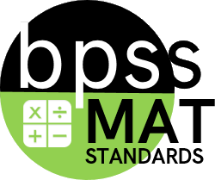BPS District Mathematics Standards Book
Math Introduction
The BPSS (MAT) Mathematics Standards course in Learnbps is Bismarck Public School District's current progress on prioritizing and deconstructing standards to provide a consistent, clear understanding of what students are expected to learn. The standards are designed to provide guidance so teachers and parents know what they need to do to help students. Plus help students reflect on the knowledge and skills that they need for success.
Identifier Explanation
MAT-01.NO.NBT.02
The Bismarck Public School District Standards-Based Progress Report displays grades at the Strand level. Therefore Bismarck Public School District has modified the North Dakota DPI Identifiers to fit into our student information system PowerSchool for Standards-Based grading. Above is a BPS-Standards MAT identifier with smaller muted text showing the addition to the identifier that are the components that BPS adds to the State code.
MAT-01.NO.NBT.02
click on the identifier components for more explanations
MAT-01.NO.NBT.02 Compare two two-digit numbers using symbols >, <, and =. Justify comparisons based on the value of tens and ones.*
Note how the identifiers auto-link to the standards global glossaries.
Math Attributes (MA)
Learners will practice and demonstrate broad, transferable, and enduring skills necessary for advancement through participation in various relevant learning experiences.(P) Problem-Solving
Analyze, execute, evaluate, and adapt approaches and solutions when solving novel situations.
MAT-K2.MA.P Learners can identify and use strategies to problem solve situations and determine an appropriate solution.
MAT-EL.MA.P Learners can develop and carry out a logical plan to problem-solve situations, reflect on the reasonableness of solutions, and explore alternate strategies with guidance.
MAT-MS.MA.P Learners can analyze information and formulate a flexible, systematic plan to problem-solve authentic situations and reflect on the reasonableness of the solution, making revisions when necessary.
MAT-HS.MA.P Learners can analyze, execute, critique, and adapt approaches and solutions when problem-solving in novel situations.
MAT-LL.MA.P Learners can integrate their cumulative knowledge and life experiences to discern and prioritize information in authentic situations, consider and apply alternative methods of resolution, and evaluate the relevance,
efficacy, and accuracy of solutions.
(C) Connections
Create connections within and across concepts, using supporting evidence to interpret how they originate, extend, and relate to other learning, ideas, and life experiences.
MAT-K2.MA.C Learners can make connections and demonstrate relationships using words, pictures, or symbols.
MAT-EL.MA.C Learners can make connections and summarize related ideas using supporting evidence.
MAT-MS.MA.C Learners can create connections within and across concepts and provide examples of how they relate to other learning and ideas using supporting evidence.
MAT-HS.MA.C Learners can create connections within and across concepts, using supporting evidence to interpret how they originate, extend, and relate to other learning, ideas, and life experiences
MAT-LL.MA.C Learners can apply connections and develop generalizations within and across concepts to execute effective decision-making or generate new ideas.
(R) Reasoning and Proof
Reason logically, citing relevant evidence to explain and critique what they see, think, and conclude through exploration, generalization, and validation.
MAT-K2.MA.R Learners can use prior knowledge and experiences to explain their thinking.
MAT-EL.MA.R Learners can reason logically based on experience and knowledge, citing evidence to support their reasoning and conclusions.
MAT-MS.MA.R Learners can reason logically, citing evidence to evaluate and explain what they see, think, and conclude through exploration and justification.
MAT-HS.MA.R Learners can reason logically, citing evidence to critique and explain what they see, think, and conclude through exploration, generalization, and validation.
MAT-LL.MA.R Learners can reason logically to discern the validity of information and synthesize it to formulate, investigate, and critique claims and evidence.
ARCHIVED BPS District Mathematics Standards Book (2017-2023)
Restore 16MB

